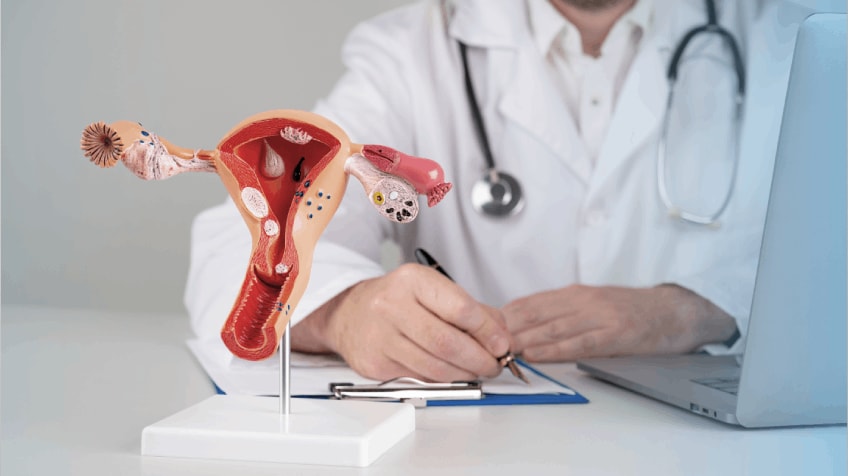When you visit your gynecologist for infertility treatment, you may often be advised to undergo certain procedures such as laparoscopy, hysteroscopy, or hysterosalpingography. These names can sound confusing — but understanding them helps ease anxiety and prepares you for your fertility journey.
In this article, Dr. Vaishali Chaudhary, Head of the Department of Reproductive Medicine and Infertility at Momstory by Sahyadri Hospitals, Pune, explains everything you need to know about hysteroscopy — what it is, why it’s done, and how it can benefit your fertility care.
What Is Hysteroscopy?
The word ‘hystero’ means uterus, and ‘scopy’ means viewing through a scope. So, hysteroscopy is a procedure that allows doctors to examine the inside of the uterus using a thin telescope-like instrument called a hysteroscope.
This hysteroscope is connected to a light source and a camera. The images from inside the uterus are displayed on a monitor, allowing the doctor to clearly see the uterine lining and identify any abnormalities.
Hysteroscopy is generally performed under short general anesthesia or local anesthesia and is a day-care procedure, meaning the patient can go home the same day.
Why Is Hysteroscopy Done?
Hysteroscopy is a diagnostic as well as therapeutic procedure. It helps in both identifying and correcting problems inside the uterus.
1. To Diagnose Heavy Menstrual Bleeding
If a woman experiences excessive menstrual bleeding or clots (known as menorrhagia), hysteroscopy helps doctors look for:
-
Uterine fibroids
-
Polyps
-
Precancerous or cancerous changes in the uterine lining
In such cases, a biopsy can also be taken during the same procedure to confirm the diagnosis.
2. To Evaluate Uterine Lining in Infertility
In fertility treatments, hysteroscopy helps assess the endometrium — the inner lining of the uterus where the embryo implants.
If the lining appears too thin or irregular, it can affect implantation and pregnancy success.
Through hysteroscopy, doctors can:
-
Check for infections or scarring (adhesions)
-
Remove abnormal tissues that may prevent implantation
-
Improve uterine health before IVF or natural conception
3. To Treat Uterine Adhesions or Fibroids
Sometimes, the uterine cavity develops thin webs of scar tissue known as adhesions (Asherman’s Syndrome). These can be safely removed during hysteroscopy using special instruments.
Additionally, submucosal fibroids — fibroids that grow inside the uterine cavity — can also be removed through hysteroscopic surgery without any external cuts.
4. To Investigate IVF Failures
In some cases, couples may experience repeated IVF failures despite good-quality embryos.
Hysteroscopy helps identify uterine factors that may be hindering implantation, such as:
-
Small polyps
-
Scar tissue
-
Inflammation or infection
Dr. Chaudhary explains that while some doctors recommend hysteroscopy for every IVF patient, she prefers to advise it only when required.
If ultrasound (2D or 3D) imaging shows a healthy endometrium, hysteroscopy may not be necessary. However, if there’s any suspicion of uterine abnormality, it becomes an important diagnostic step.
5. To Correct Cervical Stenosis
In some women, the cervical opening (the mouth of the uterus) becomes very tight — a condition known as cervical stenosis.
Hysteroscopy can help gently open the cervix, restoring a normal passage for menstrual flow or fertility treatments.
What Happens During a Hysteroscopy Procedure?
-
The patient is given mild anesthesia (local or general).
-
The hysteroscope, a very thin tube with a light and camera, is gently inserted through the cervix into the uterus.
-
The uterus is expanded slightly with saline or gas for better visibility.
-
The doctor examines the uterine cavity on a monitor and may perform a biopsy or treatment if necessary.
The procedure usually takes 15–30 minutes, and recovery is quick. Most women can resume normal activities within a day.
Is Hysteroscopy Safe?
Yes. Hysteroscopy is a minimally invasive and safe procedure when performed by experienced fertility specialists.
Some mild cramping or spotting may occur after the procedure, but serious complications are rare.
It is performed as a day-care procedure — you are admitted in the morning and discharged the same evening, with no overnight hospital stay required.
When Should You Consider Hysteroscopy?
Your gynecologist may recommend hysteroscopy if you have:
-
Heavy or irregular menstrual bleeding
-
Repeated IVF failures or pregnancy losses
-
Suspected fibroids, polyps, or uterine scarring
-
Thin or irregular endometrial lining on ultrasound
-
Unexplained infertility
Why Choose Momstory by Sahyadri Hospitals, Pune
At Momstory by Sahyadri Hospitals, fertility care goes beyond treatment — it’s about understanding each woman’s body with compassion and precision.
-
Expert Fertility Specialists like Dr. Vaishali Chaudhary
-
Advanced hysteroscopy and minimally invasive procedures
-
Personalized fertility treatment plans
-
State-of-the-art equipment and diagnostics
-
Holistic support for women’s reproductive health
Conclusion
Hysteroscopy is a simple yet powerful diagnostic and corrective procedure that plays a crucial role in fertility evaluation and treatment.
It helps identify issues that might otherwise go unnoticed and improves your chances of a successful pregnancy.
So, the next time your doctor advises a hysteroscopy, remember — it’s a safe, effective, and insightful step toward better reproductive health.
For expert fertility consultation, visit Dr. Vaishali Chaudhary at Momstory by Sahyadri Hospitals, Pune — where science meets empathy to bring your parenthood dreams closer.

